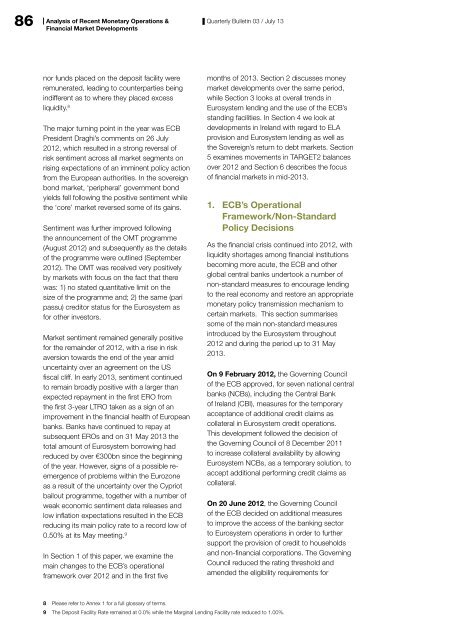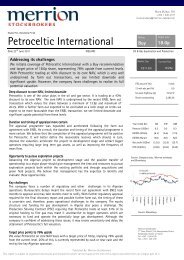Quarterly Bulletin Q3 2013
Quarterly Bulletin Q3 2013
Quarterly Bulletin Q3 2013
You also want an ePaper? Increase the reach of your titles
YUMPU automatically turns print PDFs into web optimized ePapers that Google loves.
86<br />
Analysis of Recent Monetary Operations &<br />
<strong>Quarterly</strong> <strong>Bulletin</strong> 03 / July 13<br />
Financial Market Developments<br />
nor funds placed on the deposit facility were<br />
remunerated, leading to counterparties being<br />
indifferent as to where they placed excess<br />
liquidity. 8<br />
The major turning point in the year was ECB<br />
President Draghi’s comments on 26 July<br />
2012, which resulted in a strong reversal of<br />
risk sentiment across all market segments on<br />
rising expectations of an imminent policy action<br />
from the European authorities. In the sovereign<br />
bond market, ‘peripheral’ government bond<br />
yields fell following the positive sentiment while<br />
the ‘core’ market reversed some of its gains.<br />
Sentiment was further improved following<br />
the announcement of the OMT programme<br />
(August 2012) and subsequently as the details<br />
of the programme were outlined (September<br />
2012). The OMT was received very positively<br />
by markets with focus on the fact that there<br />
was: 1) no stated quantitative limit on the<br />
size of the programme and; 2) the same (pari<br />
passu) creditor status for the Eurosystem as<br />
for other investors.<br />
Market sentiment remained generally positive<br />
for the remainder of 2012, with a rise in risk<br />
aversion towards the end of the year amid<br />
uncertainty over an agreement on the US<br />
fiscal cliff. In early <strong>2013</strong>, sentiment continued<br />
to remain broadly positive with a larger than<br />
expected repayment in the first ERO from<br />
the first 3-year LTRO taken as a sign of an<br />
improvement in the financial health of European<br />
banks. Banks have continued to repay at<br />
subsequent EROs and on 31 May <strong>2013</strong> the<br />
total amount of Eurosystem borrowing had<br />
reduced by over €300bn since the beginning<br />
of the year. However, signs of a possible reemergence<br />
of problems within the Eurozone<br />
as a result of the uncertainty over the Cypriot<br />
bailout programme, together with a number of<br />
weak economic sentiment data releases and<br />
low inflation expectations resulted in the ECB<br />
reducing its main policy rate to a record low of<br />
0.50% at its May meeting. 9<br />
In Section 1 of this paper, we examine the<br />
main changes to the ECB’s operational<br />
framework over 2012 and in the first five<br />
months of <strong>2013</strong>. Section 2 discusses money<br />
market developments over the same period,<br />
while Section 3 looks at overall trends in<br />
Eurosystem lending and the use of the ECB’s<br />
standing facilities. In Section 4 we look at<br />
developments in Ireland with regard to ELA<br />
provision and Eurosystem lending as well as<br />
the Sovereign’s return to debt markets. Section<br />
5 examines movements in TARGET2 balances<br />
over 2012 and Section 6 describes the focus<br />
of financial markets in mid-<strong>2013</strong>.<br />
1. ECB’s Operational<br />
Framework/Non-Standard<br />
Policy Decisions<br />
As the financial crisis continued into 2012, with<br />
liquidity shortages among financial institutions<br />
becoming more acute, the ECB and other<br />
global central banks undertook a number of<br />
non-standard measures to encourage lending<br />
to the real economy and restore an appropriate<br />
monetary policy transmission mechanism to<br />
certain markets. This section summarises<br />
some of the main non-standard measures<br />
introduced by the Eurosystem throughout<br />
2012 and during the period up to 31 May<br />
<strong>2013</strong>.<br />
On 9 February 2012, the Governing Council<br />
of the ECB approved, for seven national central<br />
banks (NCBs), including the Central Bank<br />
of Ireland (CBI), measures for the temporary<br />
acceptance of additional credit claims as<br />
collateral in Eurosystem credit operations.<br />
This development followed the decision of<br />
the Governing Council of 8 December 2011<br />
to increase collateral availability by allowing<br />
Eurosystem NCBs, as a temporary solution, to<br />
accept additional performing credit claims as<br />
collateral.<br />
On 20 June 2012, the Governing Council<br />
of the ECB decided on additional measures<br />
to improve the access of the banking sector<br />
to Eurosystem operations in order to further<br />
support the provision of credit to households<br />
and non-financial corporations. The Governing<br />
Council reduced the rating threshold and<br />
amended the eligibility requirements for<br />
8 Please refer to Annex 1 for a full glossary of terms.<br />
9 The Deposit Facility Rate remained at 0.0% while the Marginal Lending Facility rate reduced to 1.00%.




